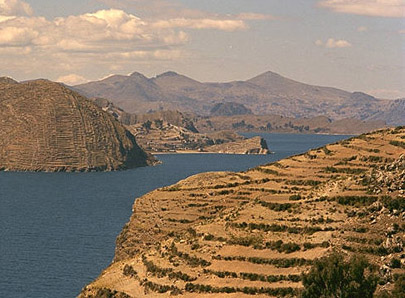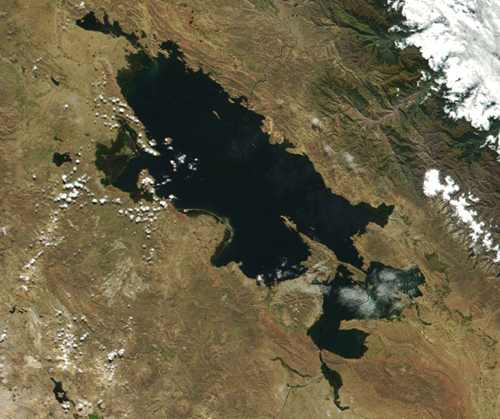Human Impact
At first, glance, the area surrounding the lake seems inhospitable. The highland climate is semi-arid with little rainfall through most of the year and the altitude results in low oxygen, although the average temperature remains relatively warm because of the lake's proximity to the equator. Despite the semi-arid conditions and lower oxygen, the lake and surrounding area has been home to humanity for nearly 8,000 years (Erickson).

Much of the land around the lake's shores and on its islands have been transformed into raised fields, terraces, irrigated pastures and sunken gardens by the local denizens. The Quechua people (descendants of the Inca), as well as the Uros and Aymara, maintain their ancestor's handiwork and continue to cultivate plants such as potatoes, barley and quinoa, a cereal crop.
Even now with today's technology available, many of the locals, such as the people living on the island of Taquile, continue to live as they did before modern times. Even using some technology, much as motorboats, the indigenous people retain their lifestyle. (Collins)
One thing that should be noted is that with the introduction of modern technology, such as fertilizers to improve farming, and tourism to the area, there is concern about pollution to the lake's waters and surrounding land. The threat of pollution and its affects on the local wildlife are of great concern to the local governments and scientists. (Messerli et al)
Water Budget and Connection to Global Climate Change
Lake Titicaca has limited sources, relying particularly on rainfall for water. The lake also has a high evaporation rate due to exposure of solar radiation. Most of this rainfall comes during December through March and during the night, when the mountain air cools enough to cause precipitation. Because the lake relies mainly on rainfall for its water, the lake can only sustain a certain amount of demand from the local populace. In fact, the maximum the lake can provide is barely under the estimated demand. (Messerli et al)
Because the annual rainfall in the area fluctuates more than fifty percent from the mean, the lake's levels are erratic and the possbility of drought or floods greatly impacts the local area and agriculture. Very little water actually drains out of the lake into rivers, most is lost to evaporation, although the lost is not substantial enough to cause the lake to be shrinking at a noticeable rate. Because the lake's available water is limited, it is critical to the locals to create a water management system to protect the lake and its waters.(Revollo)
The lake may also provide clues towards the global climate change. As said before, very little rain drains out of the lake, so it is a very reliable source of information regarding changes in precipitation over the history of the Earth. The fact the lake doesn't drain in the same way other lakes do, sediment over the past 25,000 years has settled at the lake's bottom. This provides evidence of the lake's history. Records have show that Lake Titicaca's water levels have fluctuated greatly over the years of its existence. (Baker)
|

